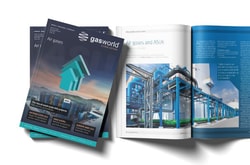Why there’s more demand for on-site dry ice production
Molly Burgess speaks to TOMCO’s Jeff Holyoak about the changing dynamics in dry ice, with signs of more companies favoring on-site, small-scale production

Welcome to our April issue, which casts a critical eye over that mainstay of industrial gas production, air gases. It has been an interesting 12 months. The story of air separation units (ASUs), which make most of the world’s air gases, is one that’s tied up with energy – its cost and its sourcing. That’s because ASUs are huge uses of electrons, around the clock and all over the world. So even if the ASU tech that separates out air gases is stable and well-understood and generally predictable, the energy side of the equation is anything but.
Molly Burgess speaks to TOMCO’s Jeff Holyoak about the changing dynamics in dry ice, with signs of more companies favoring on-site, small-scale production
One of the most notable advances in recent years when it comes to air gases is the opportunity to drive greater efficiencies with the latest real-time sensors and with data-driven self-learning tech.
Germany, Austria and Switzerland (DACH region) as well as the UK are lagging behind in the transition to Industry 4.0 technologies and embracing data-driven strategies, according to a report from IT consultancy MHP and Ludwig...
Of all the applications for air gases in relation to the decarbonisation drive, one especially promising avenue of research has recently begun a three-year pilot in Finland.
gasworld will explore carbon dioxide safety, compliance and real-time connectivity in its upcoming webinar, ‘In Conversation with CO2 Monitoring’.
It is a dynamic time when it comes to carbon dioxide (CO2). The global decarbonization drive as the world targets Net Zero has unleashed a wave of innovation in relation to finding applications for CO2...
Industrial gas major Air Liquide and state-owned energy company Shenergy have opened a joint hydrogen supply centre in Shanghai, which includes China’s first 300-bar Type II hydrogen filling facility.
Malaysia is targeting increased investment and economic growth in its carbon capture utilisation and storage (CCUS) sector after passing its CCUS Act.
As engineered carbon dioxide removal technologies mature and attract investor interest, rigorous due diligence counts more than ever.
Experienced engineer Helin Cox has been appointed Chief Technology Officer of Climeworks, the Swiss direct air capture (DAC) company.